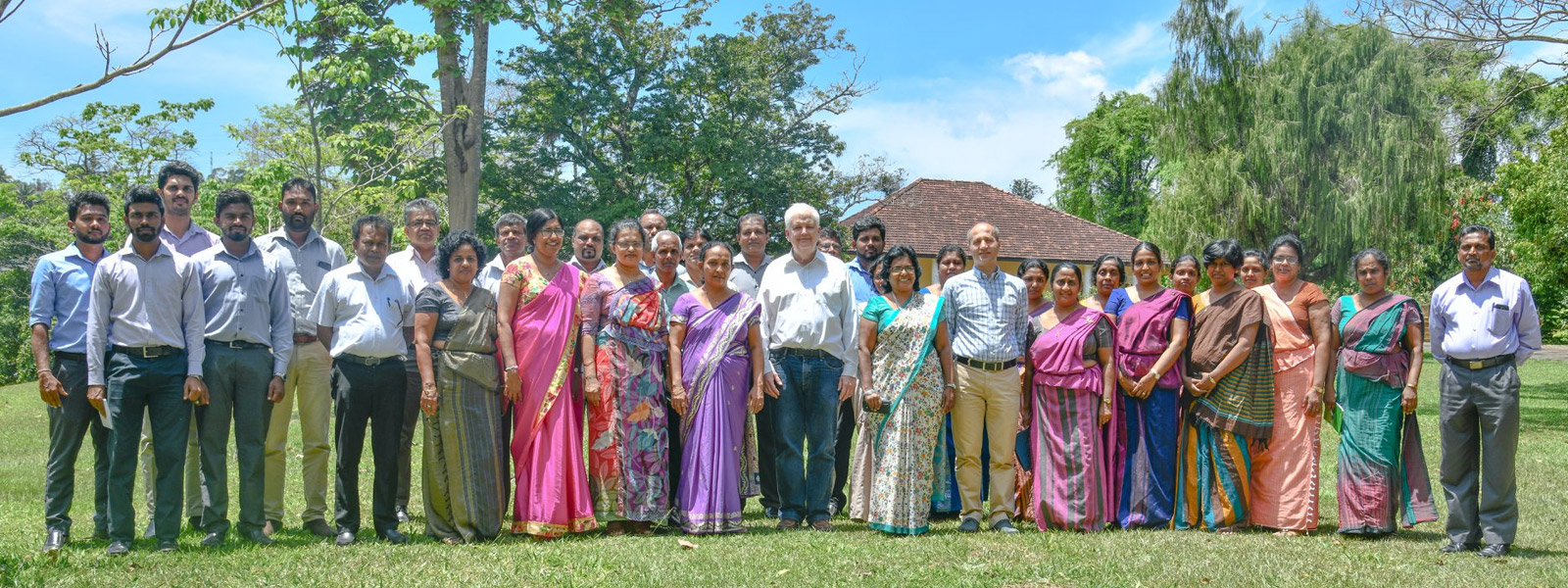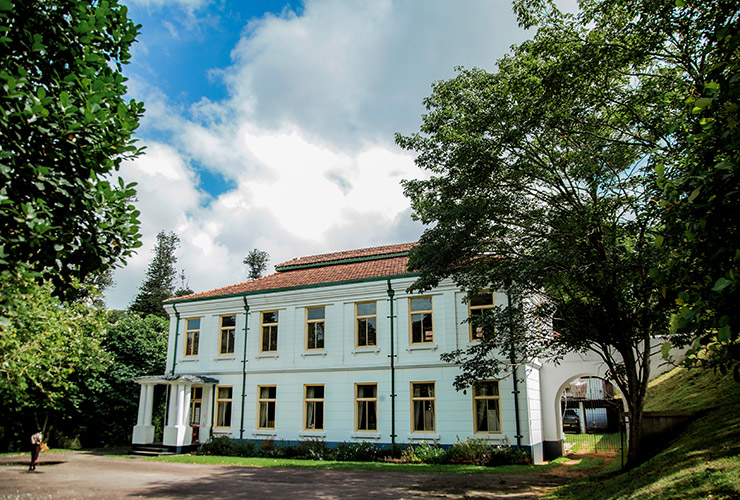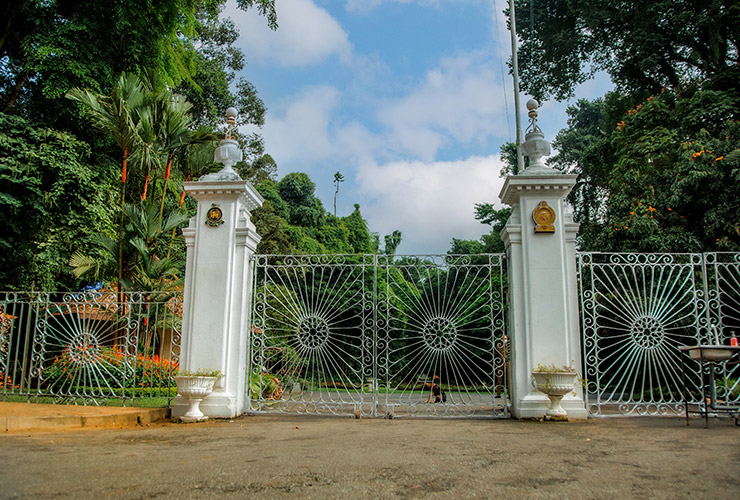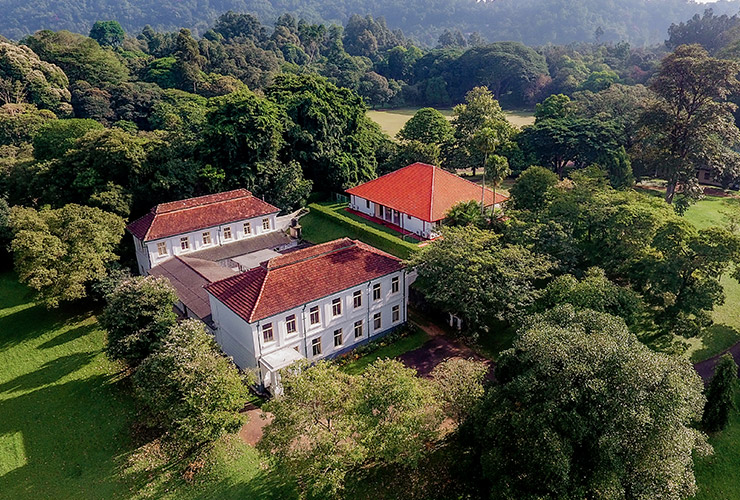National Herbarium
National Herbarium is the major national institution responsible for authentication of plants of Sri Lanka. The National Herbarium is actively involved in plant exploration, and taxonomic investigation of the flora of Sri Lanka.

It is also responsible for the documentation of floral wealth of the country. By surveying, inventorying and dissemination of information on flora, it contributes significantly to the development of the national economy. National Herbarium provides facilities to local and foreign researchers to carry out taxonomy related research and assists to identify plants correctly. It has also involve in the preparation of National Red List of Sri Lanka. The National herbarium is engaged in exchange of knowledge and specimens with the reputed herbaria and research institutes of the other parts of the world. At present scientists in the National Herbarium are engaged in studying lower plant diversity and carryout botanical surveys targeting threatened plant species of Sri Lanka.
Inauguration of the BG-Base
Inauguration of the BG-Base in Department of National Botanical Gardens, Sri Lanka
History
THE SRI LANKA NATIONAL HERBARIUM, PERADENIYA
The dried plant collection at the Peradeniya Herbarium began with the collections of Alexander Moon, Superintendent of the Botanic Gardens from 1818 to 1825 and Author of the book “A Catalogue of the Indigenous and Exotic Plants Growing in Ceylon” (1824). An active plant collection, Moon gathered a collection which is now mostly at the Kew Herbarium in England, only a few of his specimens remaining at PDA. His immediate successors made substantial additions to the Herbarium, but their specimens, being largely unnamed, were found to be not of much use. This led to an application by the British Governor, Sir Stewart Mackenzie, in the late 1820 s to Robert Wight, a botanist stationed in Madras, India to name the specimens and also to compile a new catalogue of Sri Lankan plants to take the place of Moon’s catalogue, which was found by now to be unsatisfactory and incomplete. The collection was sent to Wight, but he found it to be quite inadequate for the compilation of a catalogue. He kept it back to name the specimens and returned it in 1844 with his names, a thousand specimens gifted by him out of his own collection, and about another thousand collected, mostly in the Nilgiris in India, by George Gardner, who was new Superintendent of the Peradeniya Gardens. Gardner did much collecting in Sri Lanka, but after his death most of his herbarium was bought by the British Museum in London, England, and is now there and in Kew. G.H.K. Thwaites succeeded Gardner in 1849 as Superintendent of the Gardens. He and his assistants collected assiduously, and by 1853 he found that the number of duplicate specimens in the herbarium had risen to more than 6000. Out of these he formed several numbered sets of “Ceylon Plant” specimens, the C.P. series. Retaining a set at PDA, he distributed the others to the principal herbaria abroad and got specimens in exchange. He sold some of the specimens and used the proceeds to buy books and journals for the Herbarium library. The C.P. series forms the basis of Thwaites’ book “Enumeration Plantarum Zeylaniae”. Numbers 1 to 3859 of the series are listed with reference to page number in an index to the book on pages 451 to 468.

Most of the specimens of the C.P. series at PDA are without labels; the name of the actual collector, or of Thwaites, and other collection data are not given. On some sheets, however, the collector’s name, mostly Gardener’s, is written in pencil, but the name, place of collection and date, all pencilled, are now barely legible. The names of several other collectors who contributed to the Herbarium in its early days are to be found on some sheets. Colonel, afterwards General, J.T. Walker of the British Military establishment and his wife collected in Sri Lanka from 1830 to 1840. Some of their specimens are at Peradeniya, though most are at Kew. The new species collected by them are published by G.A. Walker – Arnott in his “Pugillus Plantarum Indiae Orientalis” (1836), and by W.J. Hooker, Wight and others.
Wight collected in Sri Lanka with the Walkers in 1836. William Ferguson, a British civil engineer, lived in Sri Lanka from 1839 to 1887. He was an enthusiastic botanist and collector and an number of his specimens are at PDA. George Wall, a businessman and author of two pamphlets ” A Catalogue of Ferns Indigenous to Ceylon” (1873) and ” A Checklist of Ceylon Ferns” (1879) was in Sri Lanka from 1846 to 1894. His collections were mainly of ferns of which many are now at PDA. Henry Trimen, author of “A Handbook to the Flora of Ceylon” (1896 – 1900) was Director of the Botanic Gardens from 1880 to 1896. Many collections were added to the Herbarium during this period, but Trimen’s or other collectors’ name is rarely seen on the sheets. The tradition of omitting the name of the collector was being continued. Trimen’s successors, particularly J.C. Willis (Director, 1896-1911) and the Government Systematic Botanists A.H.G. Alston, K.L.D. Amaratunga (1961-1985 ) and A.H.M. Jayasuriya ( 1985-1996) added a large number of specimens to the collection. T.B. Worthington, the author of the book “Ceylon Tree” (1959) left his herbarium to Kew and out of it Kew gave on loan many of his duplicates to Peradeniya. Botanists working for the Flora of Ceylon Revision Projects supported by the Smithsonian Institution (1969 – 1979) (the Smithsonian also supported an Ecological Project) and by the British ODA (1988 – 1997) made very substantial contributions to the Herbarium. The Smithsonian supported projects added nearly 40,000 specimens and the ODA – supported project nearly 20,000. In addition, botanists participating in the projects annotated the specimens with their updated names. The total number of specimens at PDA at present is about 160,000.
Services
In addition to the systematic research activities, the National Herbarium provides the following services to the public:
- Plant Identification and information service.
Serves as a National Institute for identification of plants.
Specially involves in plant identification for court cases when legal matter arises, serving the National Plant Quarantine and Customs to identify plants correctly in plant material import and export.
- Plant authentication and preservation of voucher specimens
- Plant Exploration - Surveying, collecting Plant specimens and gathering of plant related information
- Documentation of the Floral Wealth of the Country and Publication on them.
Preparing Publications on;
National Floras (Flora of Ceylon Volumes I to XV).
Provisional and District Floras.
Field Guides.
Books, Check Lists.
Brochures on Herbarium techniques, Medicinal plants, Threatened plants and lower Plants.
- Involve in the preparation of National Red List of Sri Lanka
- Teaching
Conducting of education programmes; Lectures, Work Shops, awareness programmes and Field Exploration Studies for university ,school children, other relevant institutes and people occupied in related disciplines such as:
Plant identification.
Herbarium Techniques.
Biodiversity and conservation.
Medicinal plants.
Lower plants etc.
Giving Specialist support to identify plant Groups; Flowering plants, Ferns, Bryophytes, Lichens.
- Exchange of information and material
- Providing Library facilities for botanists and other professionals.
Regulations for visitors to the Herbarium
Opening hours : from 8.30 am – 4 .00 pm on working days, entry by appointment only.
- Plant specimens brought, should be directed to the Director, Deputy Director, Systematic Botanist/ Curator or Empowered Officer for inspection before taking them into the Herbarium.
- Bringing FRESH PLANT MATERIALS is prohibited.
- Herbarium specimens should be handled with extreme care during examination and strictly consider following advices,
- They should not be turned as pages of a book
- Do not keep heavy objects or book on top of specimens and lay them with their face down
- No part of a specimen must be removed.
- Don’t write or mark on Herbarium Sheet and or Label
- Keep the specimens in order inside file covers
- Do not shuffle the files and folders when removing and returning them from cupboards
- Make sure that the cupboard are closed properly after using them
- Removal of Herbarium Sheets or Folders from the Herbarium are completely prohibited
- Special permissions must be taken to bring cameras and other electrical equipment for taking photographs
- The staff members of the Herbarium are empowered to enforce the above Herbarium Regulations
Sources of Information
Dried Plant Collection
It is the major plant repository currently containing around 160,000 dried plant specimens of Angiosperms, Gymnosperms, Ferns, Bryophytes, Lichens and Algae including 450 type specimens. Some of these specimens are nearly 180 years old and carry valuable historical information. The Herbarium contains over 450 “type specimens” – originally used specimens when describing the species, some are older than 150 years.
Classical Herbarium Collection.
New Herbarium Collection.
Library
It has a collection of nearly 3000 books on taxonomic literature and a collection of valuable botanical illustrations which mark important milestones of the botanical history of Sri Lanka.
Ancillary Collections
Botanical colour illustrations.
Yam, fruits and seeds collection.
Photographs.
Wood Anatomy Slides etc.
Contact us for more details
(+94) 081 238 8053


